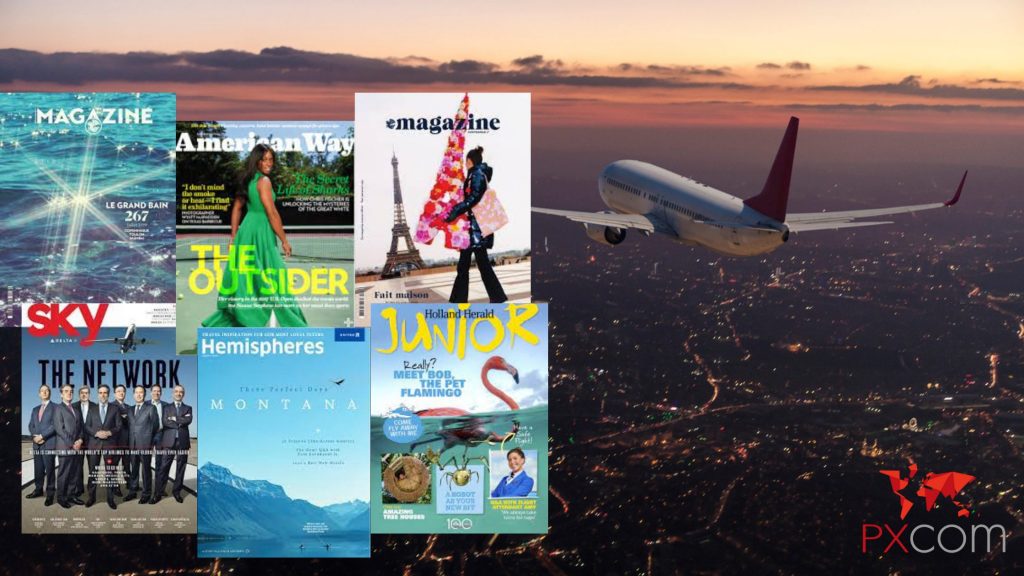


Credits: Air France, IMM International, United.com, KLM
More than a decade now since the written press experienced its revolution with the creation of the first smartphones. Since then, publishers have been constantly evolving to gain their readers’ and advertisers’ loyalty and find a viable and lasting economic model.
This change has, of course, also affected the world of consumer magazines, including those of the airlines available onboard: the in-flight magazines.More than a decade now since the written press experienced its revolution with the creation of the first smartphones. Since then, publishers have been constantly evolving to gain their readers’ and advertisers’ loyalty and find a viable and lasting economic model.
This change has, of course, also affected the world of consumer magazines, including those of the airlines available onboard: the in-flight magazines.
Magazines are an extremely important part of the communications strategy of many airlines. However, the economic, environmental impacts (overconsumption of fuel, logistics costs, etc.), and also the pandemic are leading airlines to rethink this medium. In fact, with new A330 Neo-type planes, 3L of kerosene per passenger per 100km is consumed. The weight of the long-haul flight magazines is equivalent to 2 passengers so it is 6L per 100 km.
For example, on a daily Paris – NY route, despite the performance of the new planes, removing the magazines would:
• save more than 300 tons of kerosene,
• reduce more than 800T of CO2 emissions
As for the environmental impact, for each ton of kerosene consumed, there are 3 tons of CO2 produced… Quite a challenge!
During the pandemic, Delta Air Lines spokesperson Maria Moraitakis said that they removed Sky magazine from their seatback pockets to eliminate non-essential items and reduce points of contact. In doing so, they noticed a significant reduction in carbon emissions through the discontinuation of the print magazine and continued to do so as part of its sustainability efforts. They are now shifting from magazine to webzine! Indeed, inflight magazines can be turned into an inflight webzine experience. Such an opportunity will also allow for fully digital advertising, increasing the revenue initially generated by your magazine. To achieve this goal, you can always go through an improved PDF reader, offering an "article view" for a more comfortable reading experience. But the best way to engage your passengers is to go 100% digital, giving your passengers a true web experience. This latest solution is also a good tool to pimp your website and get even more traffic through the increased SEO it generates.
Moreover, as the travel industry slowly begins to return to normal, the many effects of the COVID-19 pandemic on travel continue to be felt. Most airlines’ seatback pockets have been left empty over the past few years as a hygiene precaution against the virus.
As the matter of fact, in early 2020, a flight attendant has talked about “why you shouldn’t use the seat pockets on a plane”
The flight attendant (known as HausofDarling in Reddit) said, “one of the dirtiest places on a plane is actually the seat pocket in front of you.” It is because they never get cleaned properly and random things have been found in them such as toenails, underwear, gum, and more garbage. But then again, we tend to put our belongings in there like our phones, laptops, etc…
As proof, tests were carried out on 18 flights with Air Canada, WestJet, and Porter airlines between Ottawa and Montreal. The result is just shocking, and they found out that the dirtiest places on an airplane are:
Headrests: positive test for Staphylococcus, E. coli, and hemolytic bacteria
Seat pockets: it came next with a high number of aerobic bacteria, molds, coliforms, and E. coli.
However, digitization is increasing even before the pandemic and, as mentioned earlier, airlines are increasingly aware of their negative impact on the environment, so they really see digitized in-flight magazines as the best way to start their sustainable development effort and become eco-friendly.
Furthermore, Airlines, which once offered a wide range of daily newspapers, have yet decided to go digital by offering the same newspapers through their application that they had in print. The success of Adaptive Channel, a major player in the onboard digital press, is good evidence of this.
In addition, like the print media, inflight magazine advertising sales are declining (even before the pandemic), due to the complexity of targeting and engagement of the chosen audience. And now, many airlines have decided to eliminate them because they are considered “non-essential” and “uninteresting” to passengers due to Covid-19. But also, they want to increase their sustainability effort to go green!
In this case, for airlines looking for a simple yet efficient inflight digital platform that can take over services such as in-flight magazines and food/beverage ordering, portable W-IFE is the easiest and lowest-cost way.
Thanks to PXFly, airlines can offer the webzine to their passengers and brands will be able to create targeted and measurable campaigns with original content to offer passengers an unforgettable digital experience!
TRAVELER’S MICRO-MOMENTS Home Capturing the Traveler's Micro-Moments 26 April 2022 microMoments, Technology, traveler Time Is No Longer Measured in Days,…
IFE TO THE RESCUE Home WHEN IFE COMES TO THE RESCUE OF FLIGHT ATTENDANTS! 25 June 2022 Digital Services, IFE,…
Digital AD: IVT-FREE Zone Home DIGITAL INFLIGHT ADVERTISING: AN IVT-FREE ZONE 20 May 2022 Advertising, IVTFREE, Technology In late 2015,…